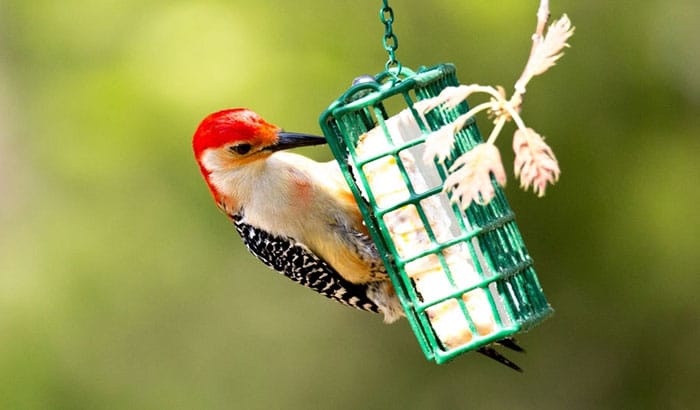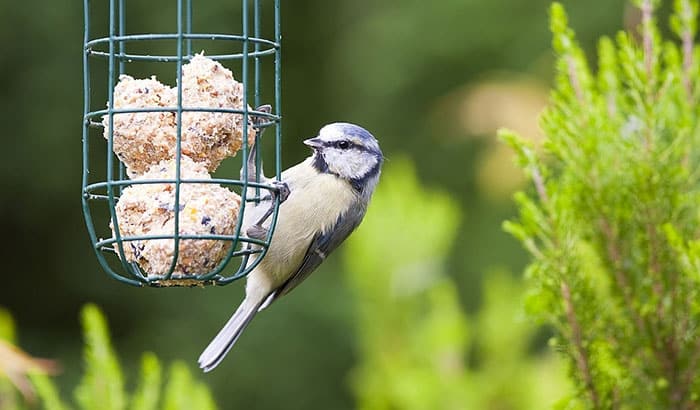If you’re interested in backyard bird feeding and about to install a suet feeder, you might want to pay extra time to understand your equipment and how it works. Among all, learning how to hang suet feeder to attract more birds is of the utmost importance.
Concerned about making a suet feeder work as expected? This article is the final answer to all your queries.
Contents
A Step-by-step Guide For Hanging A Suet Feeder
Step 1: Choose the best place to hang a suet feeder
When referring to suet feeding, finding a good place is an ultimate factor. If you’re struggling with picking the best areas for suet feeders, refer to our 5 best tips below:
Help birds see the feeder
If the birds don’t spot the feeders, they cannot eat the suet. Hence, placing your feeders somewhere obvious is a must.
If you have placed seed feeders before, you can put the suet ones close to them – but not too close. Suet-eating birds might find seed feeding activities attractive, and thus, they’ll discover the suet feeder quickly.
If your birds are a bit timid, we recommend putting the feeder in a super noticeable place, such as the middle of your backyard. Once they get used to suet feeding, you can place your suet feeders in a more hidden spot.
Follow the 5-7-9 rule
Hanging your feeder higher from the ground following the magic 5-7-9 ratio offers protection against both intimidating birds and wild animals, especially squirrels.
If your feeder lies 5 feet above the surface, 7 feet from each branch or tree, and 9 feet below the overhang, most squirrels cannot get close to your feeder. For complete squirrels’ prevention, expand 6 inches to these measurements. This technique also applies to dogs.
Additionally, post feeders with nuisance baffles can also provide birds with better protection against squirrels and other predators.
Avoid window collisions
Many birds die from window collisions each year. In their little brains, they believe that it is possible to fly non-stop as long as they can see through the window.
Hitting their head against the window while they fly at high speed is the leading cause of their death.
To limit bird collision, feeders should be at least 3 feet or even 30 feet far from your window. In either way, your birds will get optimal protection from potential accidents.
Pick a non-windy and sheltered destination
Considering a windless area for your feeder not only grants birds sanctuary but also helps to avoid the suet spillage.
Initially, your location might not be windy. However, during strong winds, hurricanes, or other severe conditions, the bird feeders or hangers may call for removal as the wind can disseminate, spill and damage the feeders.
Yet, it’s not the only problem here. Large broken branches can act as disadvantageous factors towards birds and feeders in windy circumstances, too.
Thus, it is advisable to position feeders in protected spots if your climate is highly susceptible to such storms and wind.
A sheltered position will simplify the process, make it safer for birds, and make filling and maintenance easier for owners.
Choose areas near bushes and trees
Another great place to hang your suet is on tree branches or near bushy areas. Positioning your feeders on (or under) the surrounding trees and bushes would offer better protection and comfort for birds since trees are their natural environment.
Side note: Unfortunately, squirrels and raccoons are also more accessible to the suet if you do this. Consider adding suet to another feeder to solve this problem.
Step 2: Hang your suet feeder (4 different types)
Suet comes in various shapes and forms: from a massive chunk to small balls and even crumbles. While the values stay the same for birds, different shapes and sizes of suet will fit different purposes and hanging techniques.
Suet Cage
The most popular style of suet feeders is suet cages. Thanks to the use of coated wires, the cages possess increased robustness and easy cleaning.
When used, feel free to place the feeder separately or let it attached to hopper feeders containing seeds. In addition, modern models also have tail reinforcements, which protect the birds and the suet against aggressive animals and environmental extremes.
Suet Log
Suet logs feature a typical treetop with suet-filled pre-drilled slots that promote a realistic bird habitat.
Feel free to hang these feeders near or on tree branches in a shaded area for the optimal outcome. It’d be best if the feeder is near the bird’s shelters or where they often find food.
Mesh Bag
Mesh bags are terrific for species like diamond firetails, pink robins, or chickadees. These bags also provide an efficient method of recycling and delivering suet.
You can quickly utilize a reusable bag like those for packing onions and put the suet in. Hanging these feeders in clear sights, such as on a tree or the porch, is the best way to attract birds.
Open Tray
Finally, open trays also effectively present your suet to various birds, especially those feeding on the ground. You can easily install these adaptable feeders on a window, a pole, the ground, or any available structures.
Step 3: Check for common bird feeding problems
Last but not least, go through a checklist of common suet feeding problems.
Suet Melting and Spoiling
As traditional fat accounts for most of the suet, you can witness its melting and spoil under scorching heat and direct sunlight.
One way to solve this annoying problem is to purchase the latest ready-made suet containing unique ingredients that bear higher heat. Additionally, positioning your feeders in a shaded area can also help to avoid this irritating situation.
Moreover, make sure that you prepare an adequate amount of suet for the birds to consume in 1 or 2 days. You can store unused suet in the freezer or refrigerator to preserve it.
When you’re used to doing it, you can feed suet to your birds all year round without worrying about hot weather.
Ease of Access
Feathers and spillage can make the areas messy, chasing away the birds. And lack of suet is no exception. Thus, it’s a must to clean the area regularly and ensure suet refills.
However, you will probably forget cleaning or refilling the feeder if it calls for extra steps to get to your feeders. As a result, the best place for your feeder should also be where both you and the birds access quickly.
What to Do If Birds Are Not Coming to Your Suet Feeders?
If birds don’t visit your feeders, be patient. Birds can take a while to spot the feeder and might not be eager to risk themselves for hunting and exploring the new site immediately.
If you still have no results after 2-3 weeks, try to relocate your feeder and wait again. However, if that still doesn’t work, consider installing a birdbath, using bright colors, offering neighboring perches, and refilling the suet regularly.
Conclusion
That’s all you need to know about suet feeding and how to hang suet feeder correctly. As a bonus, we’ve also presented lots of solutions to some mind-boggling problems.
Suet feeding is challenging, and you might need lots of time to get used to it. Be patient, and someday, you’ll master it!


